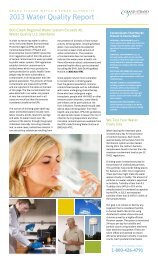Emergency Plan - Grand Strand Water and Sewer Authority
Emergency Plan - Grand Strand Water and Sewer Authority
Emergency Plan - Grand Strand Water and Sewer Authority
You also want an ePaper? Increase the reach of your titles
YUMPU automatically turns print PDFs into web optimized ePapers that Google loves.
BASIC PLAN<br />
outside resources could begin to arrive <strong>and</strong> assist.<br />
GSWSA has capabilities which, if effectively used in the event of a natural or manmade emergency,<br />
would permit us to be largely self-sufficient at:<br />
A. Protecting the lives of our employees <strong>and</strong> surrounding community which could be affected by<br />
our facilities / processes.<br />
B. Continuing the production <strong>and</strong> distribution of water for fire suppression activities <strong>and</strong> in most<br />
instances, continued distribution of potable water.<br />
C. Continuing the collection <strong>and</strong> treatment of wastewater - as well as other related sanitary <strong>and</strong><br />
environmental protection issues.<br />
If emergency incidents affect more than just GSWSA, it is likely the government of Horry County<br />
would take action to maximize the preservation of life <strong>and</strong> property. This plan prepares GSWSA to be<br />
as self-sufficient as possible but also prepares us to participate effectively as needed in regional plans<br />
implemented by Horry County <strong>and</strong> State of South Carolina, etc.<br />
Numerous agencies <strong>and</strong> organizations in the County own <strong>and</strong> operate heavy equipment, machinery,<br />
vehicles, <strong>and</strong> engineering resources which, in the event of an emergency, could be used to aid<br />
GSWSA. Additional equipment, engineering expertise, <strong>and</strong> trained equipment operators may also be<br />
available from private contractors <strong>and</strong> construction companies in our vicinity. (Refer to Appendix 4<br />
<strong>and</strong> Appendix 6.)<br />
There are a number of both formal <strong>and</strong> informal mutual aid programs that can be invoked to bring<br />
additional resources from other water <strong>and</strong>/or wastewater utilities throughout the state of South<br />
Carolina. (Examples include the South Carolina American <strong>Water</strong> Works Association (SC AWWA)<br />
<strong>Emergency</strong> Preparedness Committee’s Mutual Aid Program <strong>and</strong> the South Carolina Rural <strong>Water</strong><br />
Association’s Mutual Aid Program.)<br />
1.4. HAZARD / VULNERABILITY ANALYSIS SUMMARY<br />
The State of South Carolina developed <strong>and</strong> maintains a Hazard Analysis as part of its <strong>Emergency</strong> Operations<br />
<strong>Plan</strong> (EOP). This analysis was one of several important resources utilized in developing a Hazard /<br />
Vulnerability / Risk Analysis specific to GSWSA.<br />
Horry County coordinated the development of a Hazard Analysis as part of the Horry County All-Hazards<br />
Mitigation <strong>Plan</strong>. GSWSA serves on the <strong>Plan</strong>ning Committee for this regional plan, <strong>and</strong> participates in routine<br />
updates <strong>and</strong> revisions to this plan. This Hazard Mitigation <strong>Plan</strong> <strong>and</strong> its associated Hazard Analysis are<br />
extremely important resources utilized to develop <strong>and</strong> maintain GSWSA’s specific Hazard Analysis <strong>and</strong><br />
<strong>Emergency</strong> Management <strong>Plan</strong>s in general.<br />
The GSWSA Hazard / Vulnerability Analysis Table immediately following this section summarizes GSWSA’s<br />
specific Hazard or Vulnerability Analysis. A numeric vulnerability rating was determined for each potential<br />
type of emergency based on three major categories: probability, impact, <strong>and</strong> available response resources.<br />
Specifically, each type of emergency was rated based on the following six criteria.<br />
Probability – with 1 being the lowest likelihood of occurrence <strong>and</strong> 5 being the highest likelihood of<br />
occurrence. (The State <strong>and</strong> County analysis were extremely helpful in providing historical <strong>and</strong>/or<br />
statistical data to aid in this rating.)<br />
Human Impact – with 1 being the lowest potential number of injuries <strong>and</strong>/or deaths <strong>and</strong> 5 being the<br />
<strong>Gr<strong>and</strong></strong> <strong>Str<strong>and</strong></strong> <strong>Water</strong> & <strong>Sewer</strong> <strong>Authority</strong> 7 CONFIDENTIAL MATERIALS<br />
<strong>Emergency</strong> Management <strong>Plan</strong> SECURITY SENSITIVE<br />
June 7, 2013 NOT FOR PUBLIC DISCLOSURE






